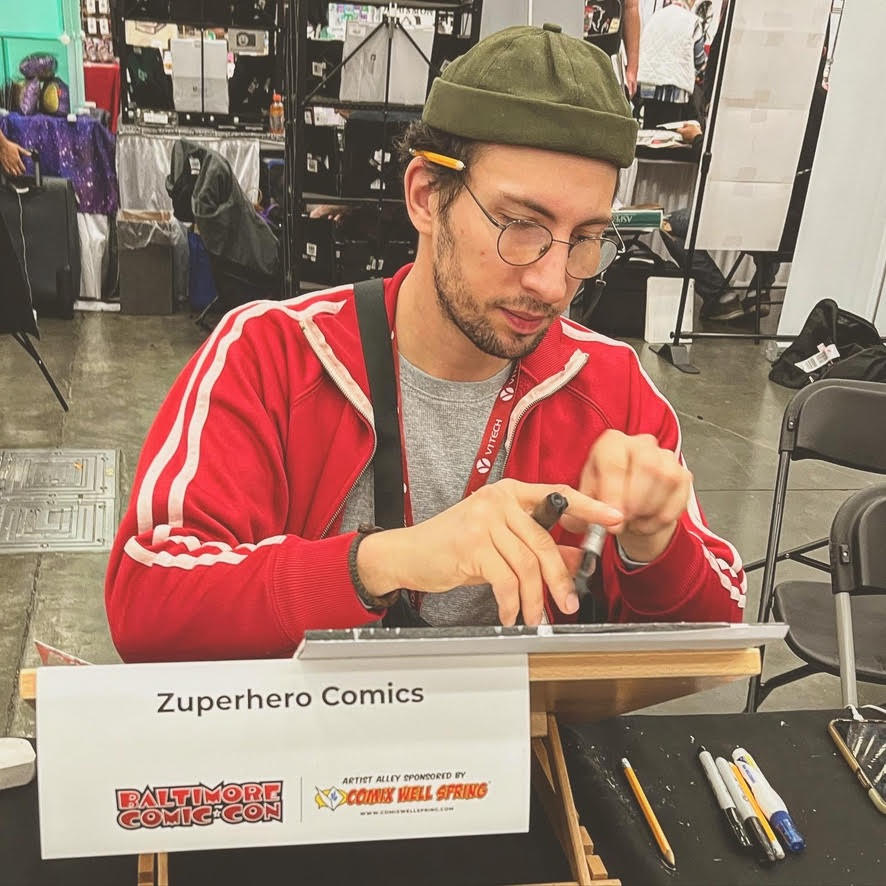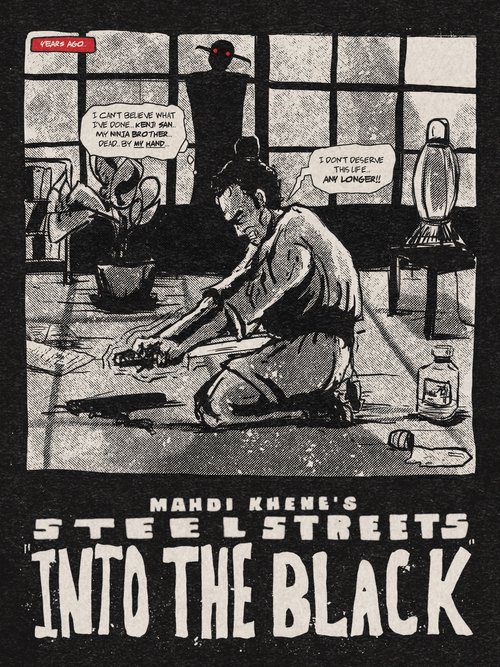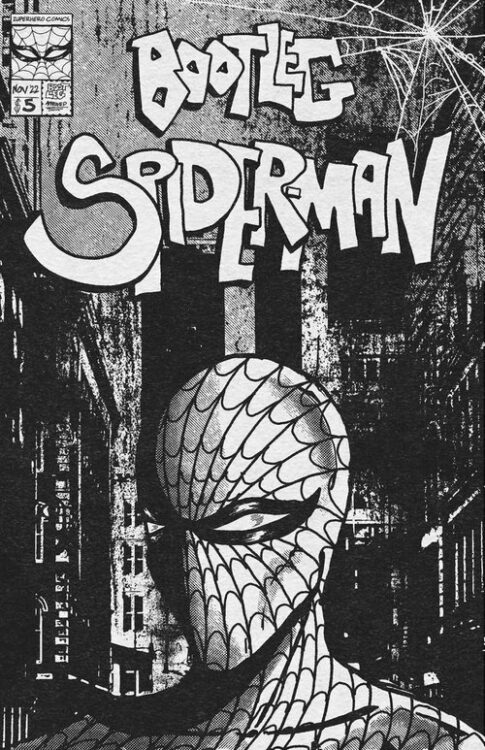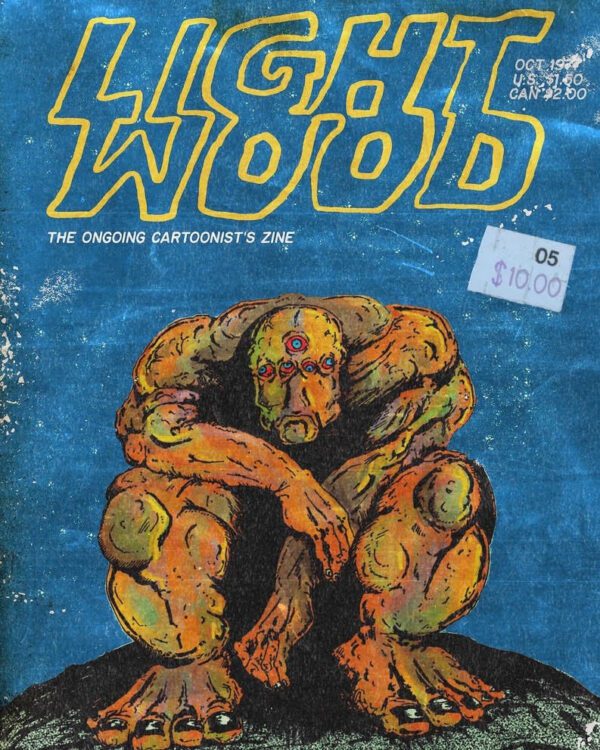Welcome to Self-Published Spotlight, a regular interview column where I will be highlighting self-published comics and the creators and small print publishers who make them.
Cartoonist Mahdi Khene recently made a big splash with his Bootleg Spider-Man ‘zine. After getting featured on the Cartoonist Kayfabe YouTube channel, this self-published ‘zine swung its way toward incredible demand and high prices. And rightfully so, as Bootleg Spider-Man was a fantastic bit of comics. But Khene is no one-hit wonder, and his self-published black-and-white comic, Steel Streets is his real masterwork. A knowing homage to Teenage Mutant Ninja Turtles, outlaw black and white comics and 80s exploitation and genre films like Robocop, Steel Streets is a must-read. The insanely prolific and busy artist took some time to answer some questions about his work, process and just comics in general. So sit back, read the interview, and then hit up Khene to grab some of his books (but good luck grabbing a copy of Bootleg Spider-Man!).

Monkeys Fighting Robots: Mahdi, thanks for talking to us! So my first question to everyone is always how they got into comics. What’s your comic book origin? DO you remember your first comic?
Mahdi Khene: My pleasure! The preverbal origin story eh? I think I must have gotten introduced to comics as a kid through books like Asterix et Obelix, Lucky Luke, Corto Maltese, etc. I’m from Algeria originally, so the Bandes Dessinees were more accessible to my family and me than what folks were reading in the states. When I was around 3 we moved to New York. Rather quickly after that, I discovered Dragon Ball Z, Spider-Man and all the Marvel comics. The McFarlane & JRJR runs definitely left their mark.
MFR: Do you still read current comics? What books do you read these days?
MK: Growing up I phased in and out of comics. I was making music, painting, making collages… So, about a year and a half ago, when I started getting back into it again, I decided to brush up on my reading! So I don’t know about current comics but I’m definitely playing catch up. For example, even though I grew up with TMNT I had no idea it had been a comic! Imagine discovering Eastman & Laird’s Teenage Mutant Ninja Turtles at 30… I’m embarrassed!
MFR: It’s never too late to discover TMNT! So when do you decide to create your own comics?
MK: I’ve always drawn since I can remember. All sorts of characters and little one-page stories… I loved the idea of a whole narrative in one picture. I remember in my 20s I had done a series of portraits where each face represented a different neighborhood in NYC. What I’d do is hang out in the neighborhood for a while and then come home and just paint a face that came to mind. Some kind of condensed, internal, sequential art. So the craft was never too far away. Right before comics, I was pursuing a music career! It was going pretty well, I had jobs lined up, residencies, etc. but then the big C happened. Covid sorta took all the gigs away, so like a lot of people I was kinda left to my own device. Then one night after binge-watching Smallville for maybe the 100th time in my life I thought, “Hey, why don’t I make up a superhero.” And that’s how the Zuperhero Universe was born. Comics gave me the artistic outlet that I needed. I fell head over heels!
MFR: Amazing “Somebody save me indeed” haha. Steel Streets is your main book, which I adore! Can you tell our readers what it’s about
MK: Thank you! Steel Streets is my homage to the comics of the 80s, the black and white boom, the gritty nature, the Ninja Turtles… It’s my tribute to the indie comics world. It’s about an amnesiac Ninja, who while seeking revenge for the death of his father is tangled up in a covert readiness project that mutates him and sets him on a collision course. I very much wanted to continue the spoofing nature of TMNT. They spoofed Frank, so I thought I’d do the same. Master Stick & Master Splinter? Master Plank! The Hand & The Foot? The Head! It’s all in good fun. 
MFR: Yeah, Teenage Mutant Ninja Turtles is the first inspiration I can see in Steel Streets, but as a Robocop superfan I see some of Officer Murphy in the main character’s design. Am I right on this? And what other books, films or media have informed Steel Streets?
MK: Haha! Yes absolutely. I think when I opened the 80s pop culture floodgates a lot of different things started coming at me. It’s New York City. I want people to read the characters with thick New York accents. I want there to be synths playing in the action sequences. I even made a fake movie poster where I had Marisa Tomei & Danny DeVito in starring roles. So yeah, spot on!
MFR: From following you on social media, I know you are very prolific and bang out work at an amazing pace. I also know your day job, like mine, is in an extremely busy industry. How do you find time to create so much work with so much quality?
MK: Yes… yes… the service industry! I’ve always loved it. I’ve been working in service for over a decade now, waiting, bartending, security, you name it! For me, it’s one of those jobs that lets my mind wander. My cafe job had really great hours that let me basically have a whole day of drawing after my shift. As for finding the time, I mean… it’s all about the hustle. I’d draw on my lunch break, before work, after work (during work…shhh don’t tell my boss!) My goal was always to do art full time so I didn’t stop. I saw a Todd McFarlane interview once where he said you had to do a page a day. So that’s what I did and still try to do.
MFR: What’s your creative process like? Analog or digital? Like how do you create an issue of Steel Streets from start to finish?
MK: It really depends on the day. I’m not a purist by any means so I use whatever tools I have at my disposal. It’s not uncommon for an issue of Steel Streets to have a mix of digital and analog pages mixed throughout. I’m lucky that my style doesn’t change with a different medium so it usually goes unnoticed. For the most part, it has to do with what I’m ABLE to do. I’ll have my iPad with me on days I work at the day job to bang out a panel, but on a day off when I’m at the studio I do enjoy ink on paper. Lately, I’ve been fusing the two where I’ll blue line the pencils digitally, print it out, and then ink traditionally. It’s all good to me.
MFR: I also love all the fake ads and dates you give the issues and ads. Was this fun aspect of the book always part of the plan? And how do you come up with those ideas?
MK: Ha! I like ‘em too. They’re a lotta fun to make. Well, that’s a tradition that comes from the first series I did, “Zuperhero Comics Presents…” Essentially I pretended that Zuperhero Comics (My publishing house) had been around since the 50s. So some books are dated 1952, some are 1965. I was just imagining an alternate world where Zuperhero Comics was pumping out books alongside Marvel & DC. That’s why that comic book is called “Zuperhero Comics Presents…” while the individual issues are called “Black & Red” or “The Adventures Of Zalool”, as if those were individual titles released by Zuperhero Comics. It gets a little Meta. As for the content of the ads… I’m just trying to make people around me laugh.
MFR: So Bootleg Spider-Man was the first thing I read from you. That ‘zine has caused quite a stir. Can you tell us how this big swing got started? Why a bootleg book?
MK: I was at Baltimore Comic Con doing a Spider-Man commission. Folks kept telling me they liked my take on Spidey, that I made him look creepy… uncanny… So that kinda launched me into a Spider-Man reading binge where I reread a bunch of Ditko, Romita, & Mcfarlane. Then one day I posted a photo on the Cartoonist Kayfabe Ringside Seats Facebook group with a caption that read “What I wouldn’t give to do a Black & White Spider-Man issue.” Someone commented that I should do a bootleg. That idea never occurred to me before! Then I thought…” Wait a second… I CAN just make a black-and-white Spider-Man issue!”. So I did.

MFR: What’s the response been like for you because I have seen it listed for sale at some outrageous prices. How did you feel when all that awesomeness started happening?
MK: Getting my own Cartoonist Kayfabe episode was a real honor. Felt like I won an award. To get so many eyes on the bootleg was amazing… but then to have those people stick around and enjoy my other work was surreal. It launched me to another level in my cartoonist career and obviously, I’m enjoying every second!
MFR: As a reader, I know what fun a bootleg book is to read and see, but as a creator what does the bootleg concept do for you?
MK: It’s fun! It’s a parody. I don’t think I’d do a serious bootleg. It’s a fun way to tribute characters that I love and make them do insane things. I’m all for it. I think it’s the only way to push the envelope a little bit. It’s cathartic in a way.
MFR: Besides Steel Streets, what else are you working on?
MK: Steel Streets is definitely my main squeeze right now but I have all sorts of little projects running around. There’s a fun underground comic I’m doing called “Full Power” & and a retro sci-fi kinda thing called The Country Gentleman And of course, Light Wood Magazine might get a second issue… All in due time!
MFR: Finally, where can readers find you and your work?
MK: You can find me on Instagram, Facebook, and Patreon under @mahdikhene. And all my books at www.zuperherocomics.com. 

